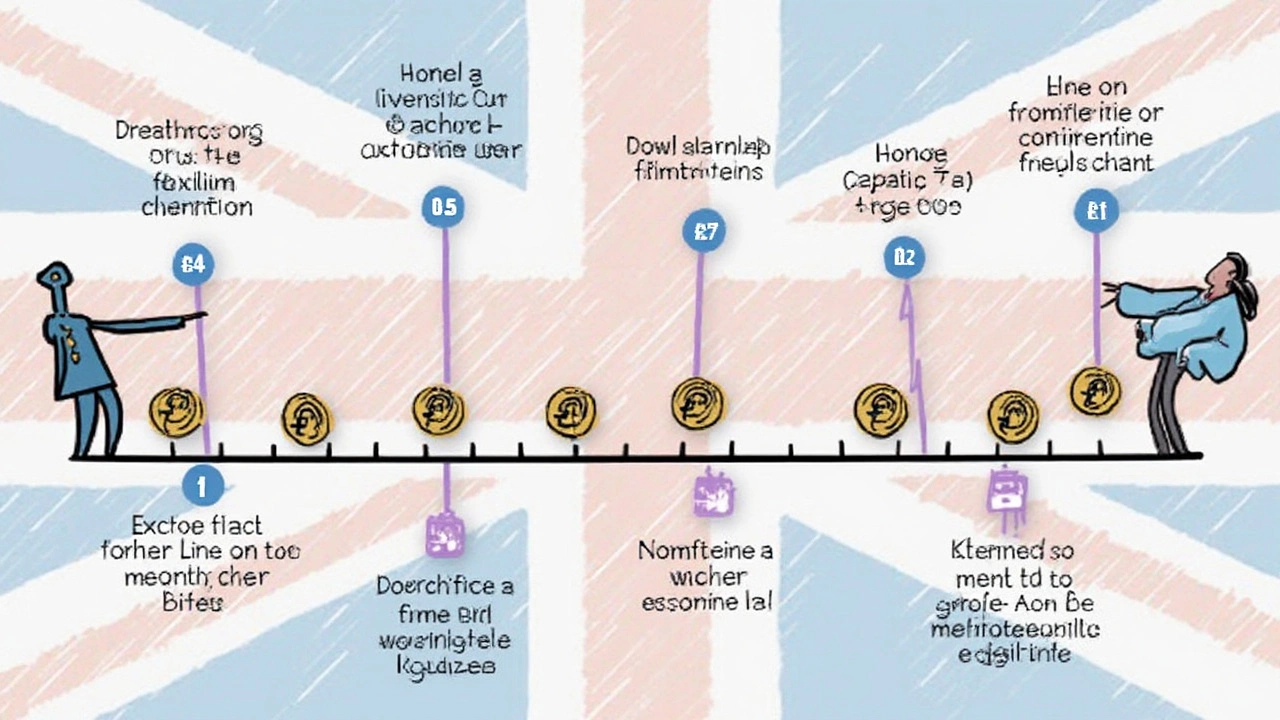Are Student Loans Forgiven After 20 Years? Here’s How It Actually Works
 Jun, 3 2025
Jun, 3 2025
If you’ve got student loans hanging over your head, you’ve probably heard people talk about them magically disappearing after 20 years. Sounds great, right? There’s truth to it, but it doesn’t happen for everyone—or automatically.
The 20-year forgiveness idea comes from certain federal repayment plans. Not all loans and not all plans qualify. In fact, plenty of people end up paying longer or miss out on forgiveness because they didn’t follow the right steps or didn’t know the fine print.
Here’s the quick version: If you’re on a qualifying income-driven repayment plan, you might get the rest of your loan wiped out after 20 or 25 years of payments, depending on your plan. Private loans and standard federal plans? Sorry, those don’t offer the same break.
It gets even more complicated when you realize you have to stay on top of paperwork, recertify your income, and watch out for possible tax hits on forgiven amounts. Slip up, and that 20-year countdown might reset or stall out completely.
If you want real answers—do your loans qualify, what should you be doing, and how do you keep from missing out? Keep reading. We’re cutting through the fog and giving you the details that matter, with zero fluff.
- What Does '20-Year Loan Forgiveness' Really Mean?
- Which Repayment Plans Qualify?
- Who's Eligible for 20-Year Forgiveness?
- How the Forgiveness Process Actually Happens
- Tips to Make Sure You Don’t Miss Out
What Does '20-Year Loan Forgiveness' Really Mean?
So, what’s the deal with the “20-year loan forgiveness” everyone talks about? Here’s the straight-up answer: For certain federal student loans, if you make payments under specific income-driven repayment plans, your remaining balance can be forgiven after 20 years. But that’s not the whole story—there are catches and a bunch of details to know.
First, it’s only federal student loans, not private ones. Second, you have to be on the right repayment plan, and not every plan offers 20-year forgiveness. For example, the Revised Pay As You Earn (REPAYE, now called SAVE) plan wipes out your remaining undergraduate loan debt after 20 years of qualifying payments. Pay As You Earn (PAYE) also does the same for any eligible federal loan.
Here’s a quick comparison of common income-driven repayment plans and their forgiveness rules:
| Repayment Plan | Forgiveness Timeline | Who Qualifies? |
|---|---|---|
| PAYE | 20 years | Most Direct Loan borrowers with financial need |
| SAVE (formerly REPAYE) | 20 years (undergrad) 25 years (grad loans) | All Direct Loan borrowers |
| Income-Based Repayment (IBR) | 20-25 years | Depends on when you took out your loans |
| Income-Contingent Repayment (ICR) | 25 years | All Direct Loan borrowers |
Now, making “qualifying payments” means you have to pay the right amount, on time, every month—no skipping, no forbearance, no drifting off into a different plan. Miss a step, and you could find your student loans stick around longer than you ever wanted.
- Payments don’t have to be consecutive, but you need to rack up the right total number within the program.
- Periods in deferment or forbearance usually don’t count toward the 20-year mark, unless covered by specific pandemic relief rules.
- You must recertify your income each year to keep your repayment plan—and the forgiveness clock—active.
And here’s a twist: After 20 years, the IRS might treat the forgiven amount as taxable income, unless future laws change. That’s a hefty bill if your balance is big.
Bottom line? 20-year forgiveness isn’t a free pass. You have to follow the plan’s rules, stick with federal loans, and keep good records—otherwise, you could miss out on this safety net.
Which Repayment Plans Qualify?
Not every payment plan lets you reach that 20-year finish line. The only way you can even think about getting student loan forgiveness after 20 years is if you’re on a specific kind of repayment plan.
Here’s the deal: Only certain federal student loans on income-driven repayment (IDR) plans can be forgiven after 20 or 25 years. Forget about 10-year Standard Repayment or random private loan setups—they don’t count.
- Pay As You Earn (PAYE): Forgiveness comes after 20 years of qualifying payments.
- Revised Pay As You Earn (REPAYE): For undergraduate loans, it’s 20 years; for grad loans, you’re looking at 25 years.
- Income-Based Repayment (IBR): If you borrowed after July 1, 2014, it’s 20 years; otherwise, 25 years to forgiveness.
- Income-Contingent Repayment (ICR): Forgiveness comes after 25 years. ICR is usually less popular because payments might be higher.
Got private loans, Parent PLUS loans, or just stuck to a Standard or Graduated plan? Sadly, you’re out of luck here. Parent PLUS loans only qualify if you consolidate to a Direct Consolidation Loan and switch to ICR—which takes 25 years, not 20.
Here’s a quick look at how the major repayment plans stack up:
| Repayment Plan | Years to Forgiveness | Eligible Loan Types |
|---|---|---|
| PAYE | 20 | Direct |
| REPAYE | 20 (UG)/25 (Grad) | Direct |
| IBR (after July 2014) | 20 | Direct, FFEL |
| IBR (before July 2014) | 25 | Direct, FFEL |
| ICR | 25 | Direct |
So if you want a shot at forgiveness after 20 years, you’ve got to be on one of these IDR plans the whole time. No skipping payments, no switching to non-qualifying plans, and no hoping private lenders will cut you the same break. Double-check that you’re in the right plan—if you aren’t sure, log into your loan dashboard and look for those repayment plan names.

Who's Eligible for 20-Year Forgiveness?
Not every borrower gets to hit reset after 20 years. To even get close, you’ve got to be on one of the federal income-driven repayment (IDR) plans designed to set your monthly payment based on your income and family size. The biggest plans that offer 20-year student loans forgiveness are called Revised Pay As You Earn (REPAYE) and the newer SAVE Plan (which replaced REPAYE in 2024).
Here’s the deal in simple terms:
- If you took out student loans only for undergraduate study and you’re on the SAVE Plan, forgiveness kicks in after 20 years of qualifying payments.
- If you’re on the old REPAYE plan with just undergraduate loans, same deal—20 years and you’re free. But if you have a grad school loan, it jumps to 25 years.
- Pay As You Earn (PAYE) repayment and Income-Based Repayment (IBR, for those who borrowed after July 1, 2014) also generally forgive the balance after 20 years, as long as you stay on those plans and keep up with paperwork.
- Only federal direct loans count. If you’ve got old FFEL loans or Perkins loans, you’ll need to consolidate into a Direct Consolidation Loan to qualify.
You’ve got to make payments for those 20 years under a qualifying plan. That doesn’t mean all your payments have to be consecutive—if you switch plans or miss recertifying your income, that can pause or restart your forgiveness timeline. Private loans? Unfortunately, those aren’t covered—at all.
One more detail: you actually have to apply for forgiveness once you hit the 20-year mark. It’s not automatic. If you’re anywhere near the finish line, get your paperwork in order and follow the Department of Education’s instructions. The whole system is tricky, so double-check your status every year to avoid surprises.
How the Forgiveness Process Actually Happens
The whole process isn’t as simple as hitting a 20-year anniversary and watching your student loans magically disappear. Here’s how it really plays out—step by step.
First, you need to be on a qualifying income-driven repayment plan the whole time, like PAYE, REPAYE, IBR, or ICR. Each payment counts toward your 20 years. If you switch plans or miss annual income recertifications, the clock can pause or even reset. That’s why keeping it consistent matters.
When you finally hit 20 years (or 25, depending on your plan and loan types), there’s a process:
- You complete your last payment.
- Your loan servicer reviews your repayment history to make sure every required payment was made under a qualifying plan and that you didn't default along the way.
- If your records check out, your remaining balance (principal and unpaid interest) is wiped out.
Keep in mind, this isn’t automatic. You’ll probably need to reach out to your servicer when you think you’re due, and they’ll trigger the review. Paperwork and patience become your best friends here, because it can take several months for your loan servicer and the Education Department to finish up the audit and clearance.
Here’s another thing: the IRS may count the forgiven balance as taxable income. This used to be a big deal. But now, thanks to a law in 2021, student loan amounts forgiven between 2021 and 2025 aren’t taxed federally. Unless that sunset date gets extended, tax bills could come back after that.
| Repayment Plan | Forgiveness Timeline | Tax on Forgiven Amount (Through 2025) |
|---|---|---|
| PAYE/REPAYE | 20 years | No |
| IBR (new borrowers) | 20 years | No |
| IBR (older borrowers), ICR | 25 years | No |
Can you speed it up? Not really. But you can make things smoother by keeping all your annual recertifications, payment history, and communication with your loan servicer saved in a folder. If issues pop up—like miscounted payments or a servicer change—you’ll be glad you had receipts.
The final word: student loans aren’t just zapped after a timer runs out. You need to stay active, organized, and a bit persistent to actually get to the finish line. It pays to know where you stand and what’s required each year, so you don’t miss your shot at forgiveness.

Tips to Make Sure You Don’t Miss Out
Missing out on student loan forgiveness after years of payments would feel like getting benched in the last few minutes of the game. Here’s how you make sure that doesn’t happen to you.
The Department of Education won’t just wipe out your loans because you hit the 20-year mark. You have to keep your info up-to-date and avoid classic slip-ups:
- Recertify Your Income Every Year: If you’re on an income-driven repayment plan, you must recertify your income and family size yearly. Miss that deadline and your payment could jump, or worse, your plan could get knocked off track—potentially resetting your forgiveness timeline.
- Track Your Payments: Not every payment counts. Only qualifying monthly payments on a legit federal income-driven plan count toward the 20 or 25 years. If you switch plans, miss payments, go into forbearance or deferment (except special cases), those months might not count.
- Get Your Paperwork in Order: Save all official letters, payment records, and annual recertification confirmations. If the loan servicer trips up with your records (it happens more than you’d think), you’ll want proof ready.
- Check Qualifying Plan/Loan Type: Only certain loan types (Direct Loans) qualify for 20-year forgiveness under income-driven plans. PLUS loans for parents aren’t eligible, for example, and older FFEL or Perkins loans need to be consolidated first. Make sure your loans are in the right basket.
- Watch for Tax Bombs: Right now, loans forgiven through income-driven repayment aren’t taxed federally through at least 2025, but that could change after that—unless Congress extends it. States can also tax forgiven debt. Bookmark that news if you’re closing in on forgiveness.
Here’s a quick breakdown of common reasons people miss out and what you can do about it:
| Common Pitfall | How To Avoid It |
|---|---|
| Forgetting to recertify income | Set annual reminders. Some servicers let you enroll in auto-reminders. |
| Switching to non-qualifying plan | Stick with income-driven plans. If you switch, double-check eligibility first. |
| Missed or late payments | Set up autopay if you can. If you miss a payment, make it up ASAP—don’t let it slide into delinquency. |
| Loan consolidation reset | Only consolidate early on. Consolidating after making payments can reset your forgiveness clock to zero. |
| Bad record-keeping | Keep your own digital folder with all loan documents and payment receipts. Don’t trust servicers to get it right forever. |
One last thing: loan servicers sometimes change. If you get reassigned, check your payment history went with you—mistakes happen.
Staying organized, watching deadlines, and knowing your plan details put you way ahead of the pack. Small habits now can mean tens of thousands saved later.
